

基于绿地微气候的长沙太平街历史文化街区热环境数值模拟
|
熊鹰(1977—),男,湖南汉寿人,教授,博士,主要研究方向为城镇化生态环境效应、人居环境可持续发展,(E-mail)csustxy@126.com; |
收稿日期: 2022-10-17
修回日期: 2022-11-21
网络出版日期: 2023-02-28
基金资助
国家自然科学基金项目(U21A2010)
长沙理工大学土木工程重点学科创新性项目(17ZDXK02)
Numerical Simulation of Thermal Environment in the Historical and Cultural District of Taiping Street Based on Greenbelt Microclimate
Received date: 2022-10-17
Revised date: 2022-11-21
Online published: 2023-02-28
以长沙太平街历史文化街区为研究对象,首先对街道空间的现状微气候环境做分析,然后基于ENVI-met软件进行数值模拟,并将研究区3种典型的街道空间的绿化优化方案的微气候数值模拟结果与基准方案的差值进行比较,进而阐释绿化优化方案的热环境调控程度。结果表明:1)随着太阳辐射逐时的变化,研究区域的热环境状况发生较大变化,在水平空间分布上呈“高温低湿”“低温高湿”特征。2)热环境质量与下垫面状况、风环境和建筑布局等因素的有关。3)3种街道空间提高街区绿地面积均可大幅降低街区平均辐射温度,乔灌+立体(水体)复合型绿地类型的热环境优化调控作用在白天均要优于乔灌、乔草方案。在绿地率一定的情况下,商业空间绿地布局中由于绿化均匀分散布局产生的树荫面积覆盖街道空间的范围最大,热环境优化调控程度的排序为分散>平行>集中,而居住空间和广场空间受建筑布局影响,绿地布局在降温增湿同时应兼具良好通风效应,因此热环境优化调控程度最大为集中布局。
熊鹰 , 章芳 , 李亮 , 尹建军 . 基于绿地微气候的长沙太平街历史文化街区热环境数值模拟[J]. 热带地理, 2023 , 43(2) : 330 -342 . DOI: 10.13284/j.cnki.rddl.003634
This study used the historical and cultural block of Taiping Street in Changsha as the research object. First the current microclimate environment of the street space was analyzed, then numerical simulations based on ENVI-met software were performed, which compared the microclimate numerical simulation results of three typical greening optimization schemes of the street space in the study area and the benchmark scheme, as well as explained the degree of thermal environment control of the greening optimization scheme. This study is expected to provide a reference for the reconstruction of urban historical blocks as well as optimization and control of the thermal environment. The results showed that: 1) With an hourly change in solar radiation, the thermal environment changed considerably, and the horizontal spatial distribution was characterized by "high temperature and low humidity" and "low temperature and high humidity." Thermal comfort is related to the underlying surface conditions, wind environment, building layout, and other factors. The low temperature and high humidity of the area with relatively concentrated green space along street spaces had a slow-release effect on the thermal environment. The ventilation effect of the area with the dense building layout was poor, and the thermal radiation of the underlying surface was high, affecting the heat dissipation and humidification in the research area. 2) The enclosed space layout of buildings in the study area caused building shadows and poor ventilation to affect the green space, which was not conducive for cooling and humidification. 3) Three types of greening transformation schemes were proposed for the street spaces of three different architectural layouts in the historical block of Taiping Street. The three kinds of street space green space optimization and benchmark schemes (the current street space situation) were simulated using ENVI-met microclimate simulation software. Optimization results showed that the same greening optimization scheme had different regulatory effects on the thermal environment in different building layouts. The three kinds of street spaces significantly reduced the average radiation temperature of the block by increasing the greening area of the block. The optimal regulatory effect of the thermal environment of the tree-shrub+three-dimensional (water) compound green space type was better than that of the tree-shrub and tree-grass scheme in the daytime. Under a certain green space ratio, the area of shade generated by the uniform and decentralized layout of green space in a commercial space covered the largest range of street space. The order of the degree of thermal environment optimization and control was decentralized>parallel>centralized. The residential and square spaces were affected by the architectural layout, and the green space layout should have good ventilation, cooling, and humidification effects; therefore, the maximum degree of thermal environment optimization and control is the centralized layout.
表1 ENVI-met模型边界条件设置参数Table 1 Setting parameter of the ENVI-met model's boundary condition |
| 类型 | 输入参数 | 参数值 |
|---|---|---|
| 气象 参数 | 初始风向 | 180°(正南风) |
| 风速(10 m) | 2.1 m/s | |
| 粗糙长度 | 0.1 | |
| 初始空气温度 | 29℃ | |
| 空气含湿率(2 500.0 m) | 7 g/kg | |
| 相对湿度 | 51% | |
| 云量 | 0 | |
| 植物 | 乔木平均高度、平均叶面积密度 | 10.0 m、0.75 m2/m³ |
| 灌木平均高度、平均叶面积密度 | 1.0 m、2.35 m2/m³ | |
| 草坪平均高度、平均叶面积密度 | 0.2 m、2.00 m2/m³ | |
| 建筑 | 室内温度 | 26℃ |
| 墙体平均传热系数、平均反射率 | 1.5W/(m2·K)、0.4 | |
| 屋顶平均传热系数、平均反射率 | 1.0W/(m2·K)、0.3 | |
| 土壤 | 表层初始温度、湿度(0~20 cm) | 304.66 K、50% |
| 中层初始温度、湿度(20~50 cm) | 305.69 K、60% | |
| 深层初始温度、湿度(>50 cm) | 305.99 K、60% |
表2 模型验证数据Table 2 Model validation data tables |
| 指标 | RMSE | MAPE/% | R 2 |
|---|---|---|---|
| 相对湿度 | 1.174 5% | 1.56 | 0.798 2 |
| 风速 | 0.560 9 m/s | 46.84 | 0.562 6 |
| 空气温度 | 1.223 2℃ | 3.30 | 0.940 7 |
图6 商业空间不同绿地面积(a)、类型(b)和布局(c)模型分别与基准模型白天微气候差值Fig.6 Difference of daytime microclimate between different green area(a), space (b), and layout (c) models and |
| a)绿地面积 | b)绿地类型 | c)绿地布局 |
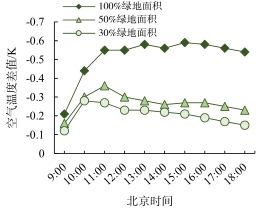 |  | 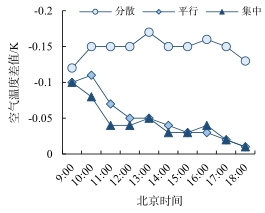 |
 | 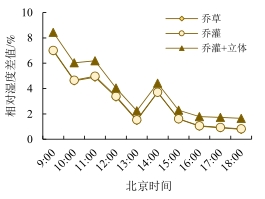 | 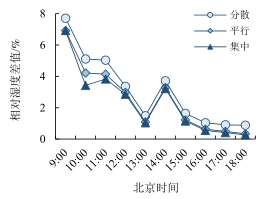 |
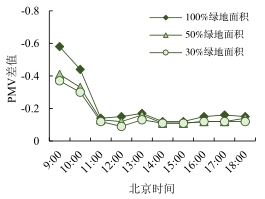 | 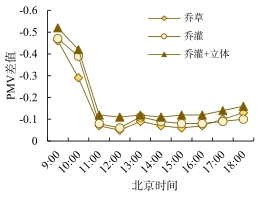 | 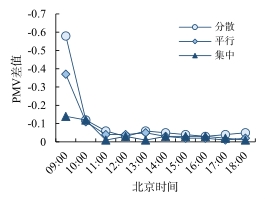 |
baseline models in the commercial space |
图7 居住空间不同绿地面积(a)、类型(b)和布局(c)模型分别与基准模型白天微气候差值Fig.7 Difference of daytime microclimate between different green area(a), space (b), and layout (c) models and baseline models in the residential space |
| a)绿地面积 | b)绿地类型 | c)绿地布局 |
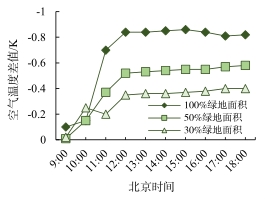 | 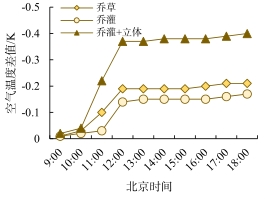 | 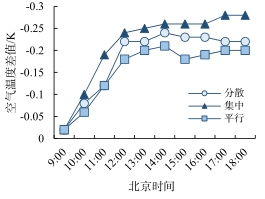 |
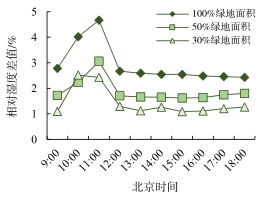 | 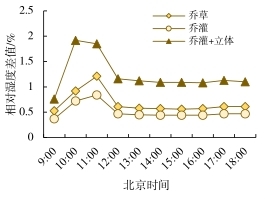 | 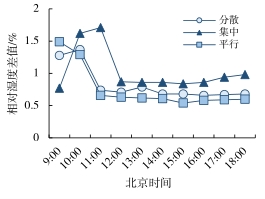 |
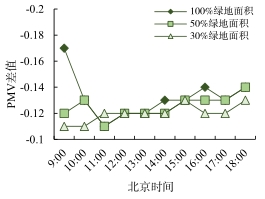 |  |  |
图8 广场空间不同绿地面积(a)、类型(b)和布局(c)模型分别与基准模型白天微气候差值Fig.8 Difference of daytime microclimate between different green area(a), space (b), and layout (c) models and baseline models in the square space |
| a)绿地面积 | b)绿地类型 | c)绿地布局 |
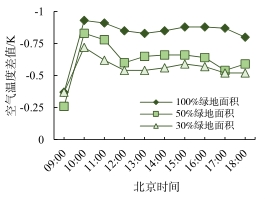 | 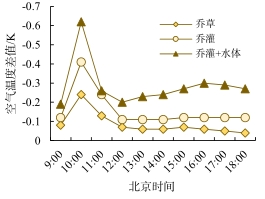 | 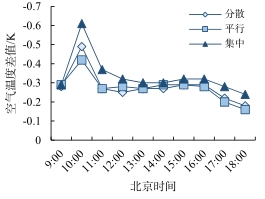 |
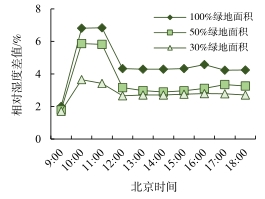 | 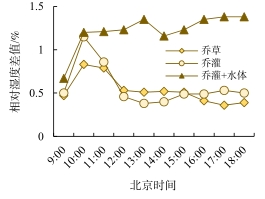 | 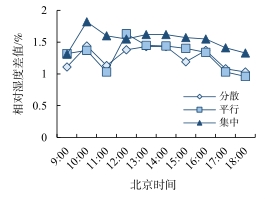 |
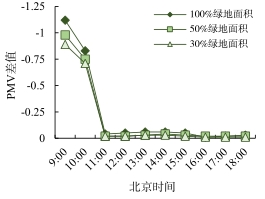 |  | 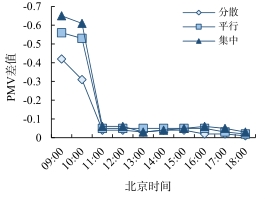 |

1 国家气象中心中国气象局气象数据中心. http://data.cma.cn/
熊 鹰:论文总体构思、设计研究方案、论文撰写及修订;
章 芳:论文撰写、实验数据采集及整理、论文修订;
李 亮:整理文献、调研、实验数据采集及整理;
尹建军:调研及数据分析。
|
Ashley N M, and Timothy W H. 2017. River Effects on the Heat Island of a Small Urban Area. Urban Climate, 21: 262-277.
|
|
Cai G, Du M, and Xue Y. 2011. Monitoring of Urban Heat Island Effect in Beijing Combining ASTER and TM Data. International Journal of Remote Sensing, 32(5): 1213-1232.
|
|
常鑫悦. 2022. 基于ENVI-met的合肥淮河路步行街区室外热舒适性评价与空间形态优化策略研究. 合肥:安徽建筑大学.
Chang Xin Yue. 2022. Study on the Evaluation of Outdoor Thermal Comfort and Optimization Strategy of Spatial Form of Pedestrian Block on Huaihe Road in Hefei Based on ENVI-Met. Hefei: Anhui University of Architecture.
|
|
戴金. 2016. 绿化对哈尔滨高层住区中心绿地微气候的影响研究.哈尔滨:哈尔滨工业大学.
Dai Jin. 2016. Effect of Greening on Microclimate of Central Greenbelt in High-Rise Residential District of Harbin. Harbin: Harbin Institute of Technology.
|
|
Dos S A R, Oliveira F S, and Silva A G. 2017. Spatial and Temporal Distribution of Urban Heat Islands. The Science of the Total Environment, (605/606): 946-956.
|
|
韩雪梅. 2019. 基于数值模拟的上海城市肌理微气候研究. 上海:华东师范大学.
Han Xuemei. 2019. Research on Shanghai Urban Texture Microclimate Based on Numerical Simulation. Shanghai: East China Normal University.
|
|
何咪. 2022. 昆明市主城区热环境时空变化及影响因素研究. 昆明:云南师范大学.
He Mi. 2022. Study on Spatio-Temporal Variation of Thermal Environment and Its Influencing Factors in the Main Urban Area of Kunming. Kunming: Yunnan Normal University.
|
|
刘春亭. 2022. 济南市不透水面时空格局演化及热环境效应研究. 济南:山东建筑大学.
Liu Chun Ting. 2022. Evolution of Spatio-Temporal Pattern and Thermal Environmental Effects of Impermeable Surface in Jinan, China. Jinan: Shandong Jianzhu University.
|
|
Michael C Ekwe, Fatimah Adamu, Joseph Gana, Grace Chika Nwafor, Rabi Usman, Jemimah Nom, Ogonnaya D Onu, Oluwatola Ibukun Adedeji, Shaba A Halilu, and Olaide M Aderoju. 2020. The Effect of Green Spaces on the Urban Thermal Environment during a Hot-Dry Season: A Case Study of Port Harcourt, Ni Geria. Environment, Development and Sustainability, 23: 10056-10079.
|
|
Pastore L, Corrao R, and Heiselberg P K. 2017. The Effects of Vegetation on Indoor Thermal Comfort: The Application of a Multi-Scale Simulation Methodology on a Residential Neighborhood Renovation Case Study. Enegr Buildings, 146: 1-11.
|
|
彭翀,邹祖钰,洪亮平,潘起胜. 2016. 旧城区风热环境模拟及其局部性更新策略研究——以武汉大智门地区为例. 城市规划,40(8):16-24.
Peng Chong,Zhou Zuyu,Hong Liangping, and Pan Qisheng. 2016. Simulation of Wind-Induced Thermal Environment in Old Town and Its Local Renewal Strategy: A Case Study of Dazhimen, Wuhan. City Planning Review, 40(8): 16-24.
|
|
戚鹏程,刘国旭. 2012. 中小城市地表温度空间分异及其与下垫面关系的遥感影像研究.气象与环境学报,28(2):44-48.
Qi Pengchen, and Liu Guoxun. 2012. Study on the Spatial Distribution of Land Surface Temperature and Its Relationship with Underlying Surface in Small and Medium-Sized Cities. Journal of Meteorology and Environmen, 28(2): 44-48.
|
|
秦文翠,胡聃,李元征,郭振. 2015. 基于ENVI-met的北京典型住宅区微气候数值模拟分析.气象与环境学报,31(3):56-62.
Qin Wencui, Hu Dan, Li Yuanzheng, and Guo Zhen. 2015. Envi-Met-Based Numerical Simulation of Microclimate in Beijing Typical Residential Areas. Journal of Meteorology and Environmen, 31(3): 56-62.
|
|
Winston T L, Chow R L, Pope C A and Martinca A J. 2011. Observing and Modeling the Nocturnal Park Cool Island of Anarid city: Horizontal and Vertical Impacts. Theor Appl Climatol, 103(1): 197-211.
|
|
王炎松,段亚鹏. 2013. 城市老街区生态适宜性评价初探——以江西黎川老街为例. 建筑与文化,3(4):87-88.
Wang Yansong, and Duan Yapeng. 2013. Ecological Suitability Assessment of Old Urban Blocks: A Case Study of Lichuan County Old Street. Architecture & Culture, 3(4): 87-88.
|
|
吴思佳,董丽,贾培义,易慧琳. 2019. 基于计算流体力学数值模拟的城市绿地温湿效应及室外热舒适评价研究进展. 风景园林,26(12):79-84.
Wu Sijia, Dong Li, Jia Peiyi, and Yi Huilin. 2019. Research Progress of Urban Green Space Temperature and Humidity Effect and Outdoor Thermal Comfort Evaluation Based on Computational Fluid Dynamics Numerical Simulation. Landscape Architecture, 26(12): 79-84.
|
|
阳金辰. 2017. 北京历史街区更新中建筑气候适应性设计策略研究. 北京:北京建筑大学.
Yang Jinchen. 2017. Research on Climate-Adaptive Design Strategy of Buildings in the Renewal of Beijing Historic Blocks. Beijing: Beijing University of Civil Engineering and Architecture.
|
|
杨云源,史正涛,何萍. 2013. 基于多源数据的昆明市主城区建筑区热环境分析. 热带地理,33(1):21-27.
Yang Yunyuan, Shi Zhengtao, and He Ping. 2013. Analysis of the Thermal Environment of the Building Area in the Main Urban Area of Kunming Based on Multi-Source Data. Tropical Geography, 33(1): 21-27.
|
|
郑子豪,陈颖彪,千庆兰,李勇,谢锦鹏. 2016. 基于三维模型的城市局地微气候模拟. 地球信息科学学报,21(9):1199-1208.
Zhen Zihang, Chen Yinbiao, Qian Qinlan, Li Yong, and Xie Jinpeng. 2016. Simulation of Urban Local Microclimate Based on 3D Model. Journal of Earth Information Science, 21(9): 1199-1208.
|
|
Zlch T, Maderspacher J, Wamsler C, and Stephan P. 2016. Using Green Infrastructure for Urban Climate-Proofing: An Evaluation of Heat Mitigation Measures at the Micro-Scale. Urban Forestry & Urban Greening, 20: 305-316.
|
|
中国建筑科学研究院. 2010. 夏热冬冷地区居住建筑节能设计标准(JGJ 134-2010). 北京:中国建筑工业出版社.
China Academy of Building Sciences. 2010. Design Standard for Energy Efficiency of Residential Buildings in Hot Summer and Cold Winter Regions (JGJ 134-2010). Beijing: China Construction Industry Press.
|
|
中国建筑科学研究院. 1993. 民用建筑热工设计规范(GB50176-1993). 北京:中国建筑工业出版社.
Chinese Academy of Building Sciences. 1993. Code for Thermal Design of Civil Buildings (GB50176-1993). Beijing: China Construction Industry Press.
|
/
| 〈 |
|
〉 |